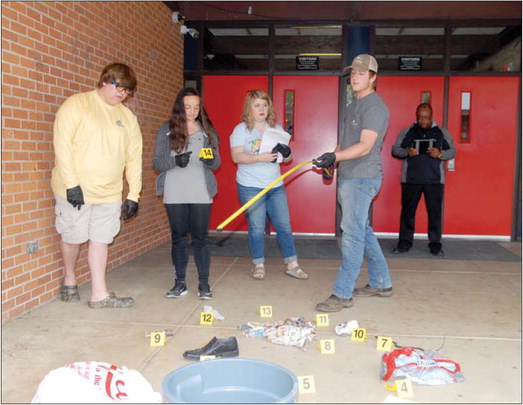Academies of West Memphis students at the scene of the crime

Academies of West Memphis students at the scene of the crime
Intro to Criminal Justice class does some CSI work
West Memphis School District The crime scene investigators laid out the evidence in meticulous detail for the jury to observe.
The case wasn't easy to discern, given its gruesome content. The measurements were taken. The location of each item placed symmetrically.
The reconstruction was all set.
Then the bell rang.
Michael Brown's fourthperiod Intro to Criminal Justice class had just finished its first day learning how to reconstruct a crime scene.
The class at the Academies of West Memphis was added this semester as part of its charter format, introducing Blue Devil students to the world of crime scene investigation in hopes that a few of them may pursue this line of work upon graduating from high school.
Brown has 27 years experience on the Memphis Police Department, the last six years of which was spent in the homicide bureau, and he said he jumped at the opportunity to teach criminal justice in West Memphis when it was publicized 'What I like most about this is teaching the kids what they don't know about police work,' said Brown. 'Most of the general public are surprised to learn about things they think can be done that actually can't be done in the legal sense. And, of course, there are some things that can be done that they don't know about.'
On this day, Brown is allowing his students to reconstruct a crime scene from an actual case that Brown handled in Memphis years ago.
It involved the homicide of a two-year-old.
The six-step process Brown has been teaching his students included: 1. Take out the evidence from the plastic barrel.
2. Spread the articles in exact location.
3. Number the items.
4. Photograph the items.
5. Measure and describe each item.
6. Collect the evidence.
'This was an unusual crime scene,' said Brown.
'Because all the evidence was in one small area. But it allowed our students to be able to take pictures of the evidence for the jurors to see.'
Brown began the class this semester by covering the history of criminal justice from the United States to England and even as far back as the Civil War era.
Also covered was police tactics and the history of the criminal justice system. Next fall Brown will teach a class covering the fundamentals of law enforcement. It will be geared toward teaching the students how to be police officers. They will partner with the Memphis Police Department through its Public Safety Technicians program.
Brown said it can lead to a part-time job with the MPD at a starting salary of $21,000 and the program will pay for two years of schooling before going into the Police Academy.
'The program pays for two years of college or 50 hours,' said Brown. 'After two years of school you will have made up your mind whether to apply for the Police Academy.'
AWM senior Ethan Burnett was part of the two foursomes who reconstructed crime scenes. He said he was surprised at how detailed the process was.
'Just the mystery of the whole process is intriguing to me,' Burnett said. 'It's a challenge, that's for sure. I have at least a small interest in pursuing this as a career, but we'll see.'
Brown said he sees potential in the class.
'I don't know for sure if (the students) are really looking into pursuing a career in criminal justice, but that's what this class is for,' said Brown. 'To find out whether they are or they are not. Statistics tell us those who end up with a career in criminal justice don't start pursuing it until they are about 21 or 22.
From what I see here there are a few students who are law enforcement material.'


By Billy Woods


Share